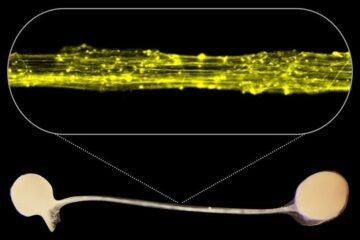Residual Volcanic Heat May Be Melting Greenland Ice

Residual heat from volcanic activity may be causing a river of ice to flow in Greenland, a new study indicates. Geologists have found that the region directly above a stream of relatively fast moving ice is thinner than a simple model of glacier change would predict. This observation, described in a report published today in the journal Science, may help researchers pin down the contribution ice sheets have made to sea level changes.
Glaciers are built up from layers of fused snow that spread out under their own weight as they accumulate, leaving a frozen record of their life history behind. Studying ice-penetrating radar images to piece together the ages of different layers in the Greenland sheet, researchers found that only significant melting could explain the thickness of an area resting above a lengthy ice flow. The old crust beneath this 600-square-kilometer region should melt about a few millimeters of ice each year; instead, up to 10 centimeters liquify. Although its true nature and duration are not clear, the hotspot is comparable in size and strength to the Yellowstone caldera, a place where the crust collapsed after a volcanic eruption. “The rates of melting are a surprise,” lead author Mark Fahnestock says, “and the fact that it’s localized in the right place [to cause the ice flow].”
Ice sheets and flows are important stores and sources of water, he adds, so understanding where they come from should improve glaciologists’ understanding of glacier behavior and corresponding changes in sea level. In an accompanying article, geologist Christina Hulbe of Portland State University notes that water melting from the base of a glacier can alter the way it moves and stores energy. This unexpected new finding, she writes, “reminds us that basal melt water matters and that it may be important in places we never suspected.”
Media Contact
More Information:
http://www.sciam.com/news/121401/2.htmlAll latest news from the category: Earth Sciences
Earth Sciences (also referred to as Geosciences), which deals with basic issues surrounding our planet, plays a vital role in the area of energy and raw materials supply.
Earth Sciences comprises subjects such as geology, geography, geological informatics, paleontology, mineralogy, petrography, crystallography, geophysics, geodesy, glaciology, cartography, photogrammetry, meteorology and seismology, early-warning systems, earthquake research and polar research.
Newest articles

First model of the brain’s information highways developed
Our human brain is not only bigger and contains more neurons than the brains of other species, but it is also connected in a special pattern: Thick bundles of neurons…

Why getting in touch with our ‘gerbil brain’ could help machines listen better
Macquarie University researchers have debunked a 75-year-old theory about how humans determine where sounds are coming from, and it could unlock the secret to creating a next generation of more…

Attosecond core-level spectroscopy reveals real-time molecular dynamics
Chemical reactions are complex mechanisms. Many different dynamical processes are involved, affecting both the electrons and the nucleus of the present atoms. Very often the strongly coupled electron and nuclear…





















